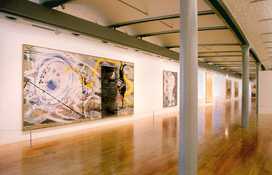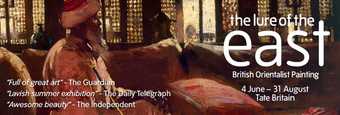I’ve known Richard Dadd’s The Fairy Feller’s Master-Stroke 1855–64 since the 1970s. When I look at it again today, it’s as if I were looking into a tapestry and losing my way. Its composition is quite unlike any other Victorian fairy painting. The point of view is not clearly defined. Instead, the individual elements appear to be linked by almost invisible forces.
The texture of the picture is all-embracing, in the ‘all-over’ style of Jackson Pollock. There is no horizon; we seem to be looking into a kind of shallow box, a diorama of scenes from nature – with one fabulous trick. Only the bright patch of earth at the bottom of the picture generates a bit of distance, the necessary breathing space.
Actually, it’s like lying in the grass and observing nature, like picking up a stone and gazing into a singular universe. It reminds me of the ‘Little World by the Wayside’, a popular series of postcards issued in the former East Germany where I grew up. It is Richard Dadd’s other world. The artist devoted a full nine years – from 1855 to 1864 – to painting the picture while locked away in the isolation of the insane asylum, Bethlem Hospital. And he painted from memory, as is so often pointed out. He spent those nine years getting every detail right, working as concisely as Albrecht Dürer did on his The Great Piece of Turf of 1503. However, Richard Dadd (1817–1886) directs the precision of his gaze at the fantastical, his hallucinating mind carrying him into increasingly elaborate, intense levels of invention.
It is the grass that holds everything together optically, lending the picture its gently magical drive, while the petalled radiance of the daisies produces large bright highlights. The composition is, in fact, dotted with round shapes, as in the large spiral movement of the vines, or the curiously curled stems. Spherical forms, distributed throughout, take the shape of hazelnuts or prickly fruits or white ruffles on a shirt. Dadd uses them, gently playing with the picture space, as he does the daisies, tipped over or seen from the side, or the puffed-up skirts of the women. The daisies also set the stage for the artist’s curious treatment of scale. The composition obeys the formal principle of dots spreading out across the picture plane – a principle that is, of course, not alien to me.
Dadd’s skilful interweaving of a powerful, depthless frontality and sensually emphasised shapes is highly sophisticated. A rich materiality prevails in this painting, an iridescence that ranges from the vegetable forms of nature to the fabrics worn by the cast of fairy characters. In view of the structures, one sometimes wonders whether the artist has depicted rock or leaf, plant or wing, body or blossom.
The idea of covering a surface with figures goes way back to Hieronymus Bosch (1450–1516) and Pieter Bruegel (1525–1569). But in Dadd’s case, there is always this special lighting, a luminosity that comes from within, a kind of fluorescent effect. White dots appear on every single tiny pebble, on the buttons of the minuscule costumes, on every little leaf – until we realise, at some point, that this is dew. Almost physically, we can follow the path of a parallel reality slowly emerging in the process of looking hard and wanting to be precise. What a difference from, say, Hercules Seghers (1589–1638) or the Impressionists, who break down what they see into generously airy, abstract patches and structures.
Richard Dadd was not only extremely well educated, he was on his way to becoming a full-blooded representative of Victorian painting before killing his father in a fit of psychosis and being subsequently confined to an institution. At that time, the fantasy life of fairies – from Grimm to Shakespeare – enjoyed widespread popularity as an imaginary world fully integrated into reality. Dadd’s appropriation of this world is, however, neither kitsch, nor facile, nor garrulous, because it does not obey the then current pictorial conventions. Nor does his vision echo the spirited confections of popular draughtsman J.J. Grandville’s fantastic book Un Autre Monde 1844. Instead, one senses the extraordinary intensity of an enduring dialogue between the artist and the universe of figures that he created. Isolated from the outside world, he painted the picture for the director of the hospital. Did he perhaps want to present it as proof of his sanity?
And his vision has nothing to do with the hallucinations caused by drugs, for nothing is distorted, there are no exaggerated metamorphoses. But the displacement, the ‘pink elephants’ of alcoholism, the experience of states such as those induced by drugs today, were then more generally accepted as constituents of life and culture. (Besides, people ate poorly, for instance, rotten meat…) If one wants to find a sign for his pathology, one could interpret the obsessive regularity of the dewdrops as symbolising a kind of self-fertilising machine.
This painting interests me with its concept of time as a self-contained sphere. There is obviously something going on in the picture plane. It does not merely depict a snarled tangle of events. It has momentum. This comes from the Fairy Feller in the foreground, his axe poised on high, ready to chop a giant hazelnut in half. The figures are in a trance, the action is suspended. This delayed, arrested act corresponds to the suspended act of painting. Just take a closer look and you will see: the artist has not finished painting his picture. The axe and the bright patch of earth still show raw, unpainted canvas. Why? Because on closer inspection, an almost divine power becomes visible that seems to rule the composition after all: the bearded figure in the centre with his huge, three-tiered crown, the Patriarch, who will give the signal for the axe to fall. He has already stretched out his hand. It is as if that moment were being delayed for all eternity by never allowing the picture to be completed. We are faced with the yawning psychological abyss of patricide.
Formally, however, the painting is anything but static or stiff; Dadd has succeeded in lending simple blades of grass an incredible energy and sense of motion. If I were asked what links this painting with my art, I would say I am reminded in particular of the Schleifenbilder of 1986, a series of whorls that I made after Dürer’s woodcut Large Triumphal Carriage of Emperor Maximilian I 1522, where the delicate curlicues are assigned to the virtues of Providencia, Acrimonia, Virilitas, Experientia, Solertia and Audacia. These ornamental loops are exactly like the tendrils of grass in Dadd’s work. They are not natural, there are no such plants – the closest they come are to our sweet peas, but then they would have blossoms.
Richard Dadd is said to have suffered sunstroke on a journey to Egypt and Palestine, causing the outbreak of his mental illness. More likely he was overwhelmed by the intensity of his impressions in this encounter with the world. Perhaps figures in the painting are not transformed people, but rather animals – beings from a middle world in a middle time. One more curlicue, a whorl, my coda follows in the form of an ancient Celtic saying:
A city lasts three years,
A dog outlives three cities,
A horse outlasts three dogs,
A person outlives three horses,
A donkey outlives three people,
A wild goose outlives three donkeys,
A crow outlives three wild geese,
A hart outlives three crows,
A raven outlives three harts,
And the Phoenix outlives three ravens.



